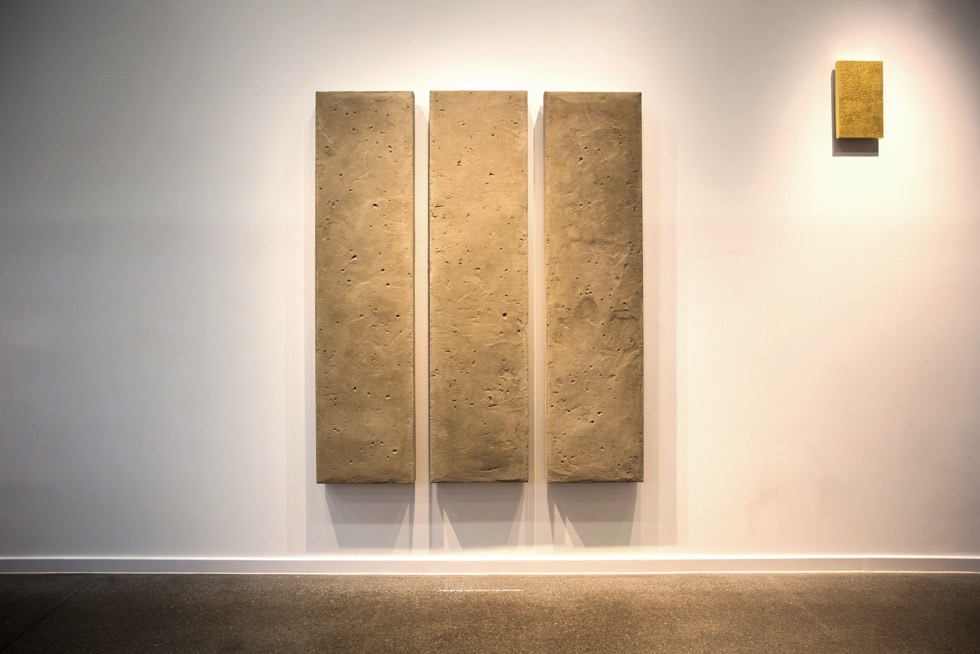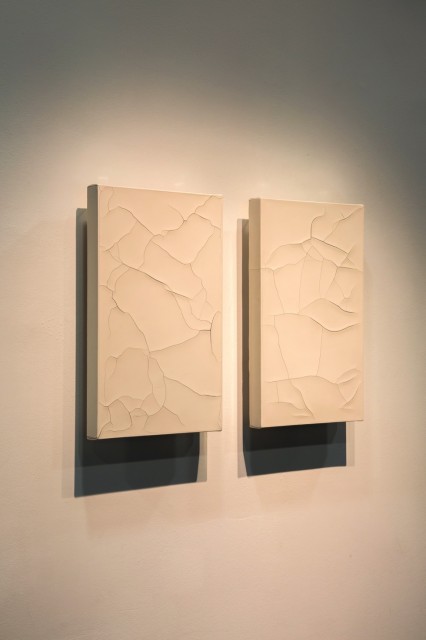In Cupped Hands: A Response To Susan Gunn’s Ground Evolution

Laura Robertson imagines what it must feel like to create Susan Gunn’s paintings; featured in her current solo exhibition, Ground Evolution, at HOME Manchester…
In cupped hands, the ground falls through her fingers; tinting skin with a fine, silky ash. Dirt clings to the rivets and lines, highlighting finger prints. Craggy pebbles make soft depressions here and there in the larger pile on the floor.
Ashes to ashes, dust to dust.
Earth, cement and brick, milled to a fine pigment. There’s an immortality to it.
It could be moon dust, pock-marked with craters. Or pavement obliterated by artillery fire. It could be pulverized volcanic glass. It could be ancient rubble, carefully scraped out from underneath a temple; separated, sampled, and archived. Solid things turned to sand, washed away, compressed, reshaped, broken up, and mined.
Who can tell, in this disintegrated state, what the dirt once was? What memories does it contain? What other hands have sifted through it?
She considers the value of what’s here, before she puts it through its final transformation: shaping the soil and stories into a final, forever object, made to hang on someone’s wall, or in a gallery or a museum, or in a succession of cities and towns. Something to be stared at and questioned and loved.

This is what I’ll make from the ashes, she thinks. This mound of buildings; reduced to wreckage, scooped up and taken from a site of transition. Pounded into nothingness. Out with the old, in with the new. Manchester is tied into a ceaseless cycle of collapse and construction. The rest of this substance, this thing in her hands, is also the bedrock for something other; it’ll be covered and replaced, flattened by new foundations and trampled by new people; decades and centuries of movement and weight that will create a stratum of rock.
Imagine a future team of archaeologists, excavating traces of TV studios and offices and coffee shops. Would they be able to identify small clues from the particles, recognising what we did here? When everything is squashed into matter, what human deeds linger?
She looks to the calcium carbonate canvases nearby. They’ve experienced a similar process. Calcium carbonate used to be bones and teeth and snails and eggs; a powder that has had multiple lives. Living, breathing things, now dry and long dead. Add liquid and slather it onto a flat surface, and it moves and shrinks and dries into a smooth porcelain. With time, this new object has become a sharp rectangle of hard cream; a surface of tectonic plates and chaos and condensed history. Hairline fractures pucker through. This is calcium set into something unpredictable; a tension of cracks finding their own way out of thin layers of cautiously applied paste. Dead matter, reborn.
In a game of one-upmanship, the darker, grittier earth she holds in her cupped hands will be tougher to manipulate. Fighting against the trowel, the cement will dry into a bruised, sandy block. She’ll make three in a row – a triptych that echoes an Assyrian relief, remembering the ruins before reconstruction; a snapshot of the in-between, of the war between old and new.
She’ll make another, smaller canvas in a shock of opulent gold. A tribute to the past and a beacon of hope. It’ll hover high up, out of reach, at the shoulder of the three. A base of lamp black pigment – ground coal – will give the entity an unexpected depth and texture. From the floor, it’ll look like a far-away obelisk dipped in liquid gold; the ash will fall away, revealing an improbable, floating structure; an orbital city gleaming in the light.
From cupped hands, a speculative future will emerge.
Laura Robertson
A note from the author: the protagonist, ‘She’, could be Susan or me. After spending time at Ground Evolution, HOME Manchester, and at Susan’s Salford studio, I found myself visualising how it felt to make her canvases. To be her, with different materials and processes and tools, patiently applying layer after layer after layer of handmade paint. Waiting. Thinking about origin stories, visual memory, and possible futures; and what these artworks might carry with them once they’re ‘finished’ and have broken free.
See Susan Gunn: Ground Evolution at HOME Projects, Manchester, until 1 July 2018 — FREE
In Ground Evolution, Gunn has harvested earth, concrete and stone from the St John’s site at Old Granada Studios where the new Rem Koolhaas designed Factory arts building will be built. A historical site of invention and budding creativity forms the concept and idea behind new, experimental work included in this show. Earth excavated from this area has been subject to a mechanical process to transform it into a dust resembling pigment.
See more of the artist’s work at susangunn.co.uk





